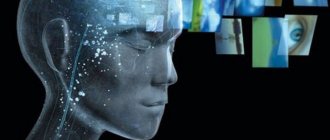Every day, every person is bombarded with a huge amount of information. We encounter new situations, objects, phenomena. Some people cope with this flow of knowledge without problems and successfully use it to their advantage. Others have difficulty remembering anything. This situation is largely explained by a person’s belonging to a certain type in terms of the way they perceive information. If it is served in a form that is inconvenient for humans, then its processing will be extremely difficult.
What is information?
The concept of “information” has an abstract meaning and its definition largely depends on the context. Translated from Latin, this word means “clarification”, “presentation”, “familiarization”. Most often, the term “information” refers to new facts that are perceived and understood by a person, and also found useful. In the process of processing this information received for the first time, people gain certain knowledge.
How is information received?
The perception of information by a person is an acquaintance with phenomena and objects through their impact on various senses. By analyzing the result of the impact of a particular object or situation on the organs of vision, hearing, smell, taste and touch, the individual receives a certain idea about them. Thus, the basis in the process of perceiving information is our five senses. In this case, a person’s past experience and previously acquired knowledge are actively involved. By referring to them, you can attribute the information received to already known phenomena or separate them from the general mass into a separate category. Methods of perceiving information are based on some processes associated with the human psyche:
- thinking (having seen or heard an object or phenomenon, a person, starting to think, realizes what he is faced with);
- speech (the ability to name the object of perception);
- feelings (various types of reactions to objects of perception);
- will (a person’s ability to organize the process of perception).
Presentation of information
According to this parameter, information can be divided into the following types:
- Text. It is represented in the form of all kinds of symbols, which, when combined with each other, make it possible to obtain words, phrases, sentences in any language.
- Numeric. This is information represented by numbers and signs that express a certain mathematical operation.
- Sound. This is directly oral speech, thanks to which information from one person is transmitted to another, and various audio recordings.
- Graphic. It includes diagrams, graphs, drawings and other images.
Perception and presentation of information are inextricably linked. Each person tries to choose exactly the option for presenting data that will ensure the best understanding of it.
Ways of human perception of information
A person has several such methods at his disposal. They are determined by the five senses: vision, hearing, touch, taste and smell. In this regard, there is a certain classification of information according to the method of perception:
- visual;
- sound;
- tactile;
- taste;
- olfactory.
Visual information is perceived through the eyes. Thanks to them, various visual images enter the human brain, which are then processed there. Hearing is necessary for the perception of information coming in the form of sounds (speech, noise, music, signals). The organs of touch are responsible for the ability to perceive tactile information. Receptors located on the skin make it possible to estimate the temperature of the object under study, the type of its surface, and shape. Taste information enters the brain from receptors on the tongue and is converted into a signal by which a person understands what product it is: sour, sweet, bitter or salty. The sense of smell also helps us understand the world around us, allowing us to distinguish and identify all kinds of smells. Vision plays the main role in the perception of information. It accounts for about 90% of the knowledge gained. The sound way of perceiving information (radio broadcast, for example) makes up about 9%, and the other senses are responsible for only 1%.
Gregory's Visual Inference Theory
Psychologist Richard Gregory (1970) was convinced that visual perception depends on top-down processing.
Top-down processing, or conceptually driven processing, occurs when we form a picture of the big picture from small details. We make assumptions about what we see based on expectations, beliefs, prior knowledge, and previous experiences. In other words, we are making an educated guess.
Gregory's theory is supported by numerous evidence and experiments. One of the most famous examples is the hollow mask effect:
When the mask is turned to the hollow side, you see a normal face
Gregory used Charlie Chaplin's rotating mask to explain how we perceive the hollow surface of a mask as bulges based on our beliefs about the world. According to our previous knowledge of facial structure, the nose should protrude. As a result, we subconsciously reconstruct the hollow face and see a normal one.
How do we perceive visual information according to Gregory's theory?
1. Almost 90% of information received through the eyes does not reach the brain. Thus, the brain uses previous experience or existing knowledge to construct reality.
2. The visual information that we perceive is combined with previously stored information about the world that we have acquired through experience.
3. Based on various examples of the theory of top-down information processing, it follows that pattern recognition is based on contextual information.
Tip: Enhance your content with an appropriate theme and design; use a meaningful headline to set key expectations; Support your visuals with expressive text.
- Why do stereotypical landing pages and websites convert better?
Types of perception
The same information, obtained in any particular way, is perceived differently by each person. Someone, after reading one of the pages of a book for a minute, can easily retell its contents, while others will remember practically nothing. But if such a person reads the same text out loud, he will easily reproduce in his memory what he heard. Such differences determine the characteristics of people’s perception of information, each of which is inherent in a certain type. There are four in total:
- Visuals.
- Auditory learners.
- Kinesthetics.
- Discrete.
It is often very important to know what type of information perception is dominant for a person and how it is characterized. This significantly improves mutual understanding between people and makes it possible to convey the necessary information to your interlocutor as quickly and completely as possible.
The influence of typography and aesthetics on the reading process
Did you know that typography can influence a person's mood and ability to make decisions?
Typography is the design and use of type as a means of visual communication. Nowadays, typography has moved from the field of book printing into the digital sphere. Summarizing all possible definitions of the term, we can say that the purpose of typography is to improve the visual perception of text.
In an experiment, Kevin Larson (Microsoft) and Rosalind Picard (MIT) found out how typography affects a reader's mood and problem-solving ability.
They conducted two studies, each involving 20 people. Participants were divided into two equal groups and given 20 minutes to read an issue of The New Yorker magazine on a tablet. One group received a text with bad typography, the other - with good typography (examples are given below):
During the experiment, participants were interrupted and asked how much time they thought had passed since the start of the experiment. According to psychological research (Weybrew, 1984), people who find their activities enjoyable and are in a positive mood report spending significantly less time reading.
After reading the texts, the experiment participants were asked to solve the candle problem. They had to attach the candle to the wall so that the wax would not drip, using pushpins.
How do we perceive good typography and its impact?
- Both groups of participants misestimated the time spent reading. This means that reading was a fun activity for them.
- Participants who were presented with text with good typography significantly underestimated their reading time compared to participants who were presented with text with poor typography. This means that they found the first text more interesting.
- None of the participants who read the text with poor typography were able to solve the candle problem. While less than half of the second group completed the task. Thus, good typography influenced the ability to solve problems.
Good typography influences the mood of users and their ability to make decisions
Tweet Quote
Tip: use readable fonts; separate text from images; do not overlay pictures or icons on the text; leave enough white space between paragraphs.
- Anatomy of a font: a visual guide to typography
Visuals
These are people for whom vision is the main sense organ in the process of learning about the world around them and perceiving information. They remember new material well if they see it in the form of text, pictures, diagrams and graphs. In the speech of visual learners, there are often words that are in one way or another connected with the characteristics of objects by their external features, the function of vision itself (“let’s see”, “light”, “bright”, “will be visible”, “it seems to me”). Such people usually speak loudly, quickly, and gesticulate actively. Visual people pay great attention to their appearance and surrounding environment.
Errors in perception (illusions)
There is nothing perfect in the world, and perception is no exception. For various reasons, this process can “fail” and give the individual erroneous images that do not correspond to reality.
There are two types of such violations:
- illusions are a perverted perception of existing objects and phenomena. Illusions, in turn, are: affectogenic - they are caused by feelings and emotions. For example, an anxious person may see an approaching maniac or monster in the shadow of a tree, hear a threat in someone else’s speech, a shy person will see criticism and shaming everywhere;
- pareidolic - the emergence of fantastic images when interacting with reality (blood in a glass instead of water, beetles instead of dirt stains). This type of illusion is a precursor to hallucinations.
This disorder is independently present only in mentally ill people - psychotics (for example, schizophrenics). The only condition under which a normal person can temporarily see hallucinations is a forced change in mental state (hypnosis, drugs).
Audials
For auditory learners, it is much easier to learn something that they have heard once, rather than seen a hundred times. The peculiarities of such people’s perception of information lie in their ability to listen and remember well what is said, both in a conversation with colleagues or relatives, and at a lecture at an institute or at a work seminar. Auditory learners have a large vocabulary and are pleasant to communicate with. Such people know how to perfectly convince their interlocutor in a conversation with him. They prefer quiet activities to active pastimes; they like to listen to music.
Discrete
The ways of perceiving information are directly related to the human senses. The majority of people gain knowledge through sight, hearing, touch, smell and taste. However, types of information perception include those that are primarily associated with thinking. People who perceive the world around them in this way are called discretes. There are quite a few of them, and they are found only among adults, since logic is not sufficiently developed in children. At a young age, the main ways of perceiving discrete information are visual and auditory. And only with age do they begin to actively think about what they saw and heard, while discovering new knowledge for themselves.
Type of perception and learning ability
The ways people perceive information largely determine the form of learning that will be most effective for them. Of course, there are no people who would receive new knowledge entirely with the help of one sense organ or a group of them, for example, touch and smell. All of them act as means of perceiving information. However, knowing which sense organs are dominant in a particular person allows others to quickly convey the necessary information to him, and allows the person himself to effectively organize the process of self-education.
Visual learners, for example, need to present all new information in a readable form, in pictures and diagrams. In this case, they remember it much better. Visual people usually excel in the exact sciences. Even in childhood, they are excellent at putting together puzzles, know many geometric shapes, are good at drawing, sketching, and building with cubes or construction sets.
Auditory learners, on the contrary, more easily perceive information received from oral speech. This could be a conversation with someone, a lecture, an audio recording. When teaching a foreign language for auditory learners, audio courses are preferable to a printed tutorial. If you still need to remember the written text, it is better to speak it out loud.
Kinesthetic learners are very mobile. They find it difficult to concentrate on anything for long periods of time. Such people find it difficult to learn material learned at a lecture or from a textbook. The memorization process will go faster if kinesthetic learners learn to connect theory and practice. It is easier for them to learn sciences such as physics, chemistry, biology, in which a specific scientific term or law can be represented as the result of an experiment carried out in a laboratory.
Discrete people take a little longer than other people to take new information into account. They must first comprehend it and relate it to their past experience. Such people can, for example, record a teacher’s lecture on a dictaphone and subsequently listen to it a second time. Among the discretes there are many people of science, since rationality and logic are above all else for them. Therefore, in the process of studying, they will be closest to those subjects in which accuracy determines the perception of information - computer science, for example.
Kinesthetics
Around the world, approximately 20% of people are kinesthetic learners. This is a person of feelings and sensations, his perception of the world is by touch, that is, with the help of movements and through smell and touch. Kinesthetics are characterized by the fact that they breathe deeply through the stomach, rather than through the chest.
They have a low, deep, hoarse or muffled voice, and their speech is slow, separated by expressive pauses. Kinesthetic people tend to slouch and sit slightly leaning forward. Their gaze is almost always downward. In clothing, they value, above all, comfort, relegating its appearance to the background. By nature, kinesthetic people are very gentle and good-natured people , always cheerful and with a good sense of humor. Their image is complemented by plump lips and pink skin; they tend to be overweight.
A kinesthetic person is, first of all, a person of action. To learn something, they need to put it into practice to better understand the information. If a kinesthetic learner needs to study the instructions for using something, then he will rush to try it out in practice one day, rather than re-read its contents many times. But this does not mean at all that representatives of this type are too mobile; it is easier for them to understand the world around them.
Kinesthetic learners have very well developed muscle memory, so they quickly memorize various motor actions ; sports such as swimming and cycling are easy for them.
For a person who is kinesthetic, the following expressions are typical:
- "make contact";
- "I feel";
- "change for the better";
- "to catch something";
- "hand in hand";
- "solid foundation";
- “manage oneself”;
- "keep calm";
- “We are very close to solving the problem.”
Kinesthetic learners, unlike visual learners, simply love touching and hugging, even with strangers. Their personal space does not have clear boundaries, so kinesthetics will not take closed poses and reject the desire of another person to approach them. After all, they are sure that they can get to know a person better and make friends with him mainly through touch. However, kinesthetics are not ready to let everyone into their inner world, but only the “chosen ones.” It is not surprising that kinesthetics have a unique ability to experience strong and deep feelings , and their attachments are strong and durable.
Role in communication
The types of information perception also influence how best to communicate with a person so that he listens to you. For visual learners, the appearance of the interlocutor is very important. The slightest carelessness in clothing can turn him off, after which it will not matter at all what he says. When talking with a visual person, you need to pay attention to your facial expressions, speak quickly using gestures, and support the conversation with schematic drawings.
In a conversation with an auditory learner, there should be words that are close to him (“listen to me”, “sounds tempting”, “this says a lot”). The perception of information by an auditory person depends largely on how the interlocutor speaks. The timbre of the voice should be calm and pleasant. It is better to postpone an important conversation with an auditory person if you have a severe cold. Such people also cannot tolerate shrill notes in their voices.
Negotiations with a kinesthetic person should be carried out in a room with a comfortable air temperature and a pleasant smell. Such people sometimes need to touch the interlocutor, so they better understand what they heard or saw. You shouldn’t expect a kinesthetic learner to make a quick decision immediately after the conversation. He needs time to listen to his feelings and understand that he is doing everything right.
Dialogue with discrete people must be built on the principle of rationality. It is best to operate with strict scientific facts and rules. For discrete data, the language of numbers is more understandable.
Sanoka and Sulman's experiment on color relationships
According to numerous psychological studies, combinations of homogeneous colors are more harmonious and pleasant. While contrasting colors are usually associated with chaos and aggression.
In 2011, Thomas Sanocki and Noah Sulman conducted an experiment to study how color combinations affect short-term memory - our ability to remember what we just saw.
Four different experiments were conducted using harmonious and disharmonious color palettes. In each trial, participants were shown two palettes: first one, then a second, which had to be compared with the first. The palettes were shown at a certain time interval and several times in random combinations. The subjects had to determine whether the palettes were the same or different. Also, the experiment participants had to evaluate the harmony of the palette - a pleasant/unpleasant combination of colors.
Below are 4 examples of palettes that were shown to participants in the experiment:
An experiment by Sanoka and Sulman showed how colors affect our visual perception:
- People remember better those palettes in which the colors are combined with each other.
- People remember palettes that contain a combination of only three or fewer colors better than those that contain four or more colors.
- The contrast of adjacent colors affects how well a person remembers a color scheme. In other words, this means that the color difference between the text and the background of the landing page increases the ability to concentrate on its content.
- We can remember quite a large number of color combinations at the same time.
In other words, people are better able to absorb and remember more information when it is presented on a page with a contrasting but harmonious color scheme, preferably a combination of three or fewer colors.
Contrasting and harmonious color combinations improve the perception and memorization of content
Tweet Quote
Tip: Use as few different colors as possible in complex content; increase the contrast between the visual information and the background; choose themes with a harmonious combination of shades; use disharmonious color combinations wisely.
- Low contrast text - a fashion trend or a usability killer











